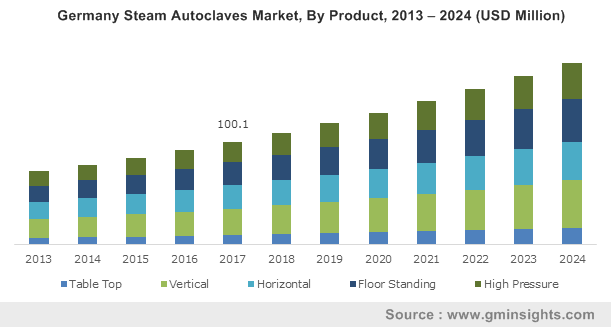Steam autoclaves market to be characterized by the surging product demand from laboratories, development of next-gen equipment to fuel the industry landscape
Publisher : Fractovia | Latest Update: November 2018 | Published Date : July 2016Request Sample
The extensive use of sterilizing surgical equipment in pharmaceutical and biomedical applications has been propelling steam autoclaves market share over the last few years. The primary reason for the massive deployment of these products in medical applications is the nontoxic and inexpensive nature of the steam sterilization process. As of now, most of the hospitals and dental clinics have been deploying autoclaves prominently to provide clean and bacteria free medical services to the patients.
Germany Steam Autoclaves Market, By Product, 2013 – 2024 (USD Million)

Of late, as has been observed, some of the hospitals have even been setting their own design of autoclaves for their particular in-house applications. The in-house designing strategy has also been attracting steam autoclave manufacturers that have been developing products suitable for certain customers. A lot more companies have been launching next-generation steam autoclaves that would streamline the industry trends over the years ahead.
In order to meet the specific needs of customers, most of the players in the steam autoclaves market have been manufacturing products right from the base level – that is to say, the launch of totally new and organized sterilizing equipment is now in focus. A few months before, the Swedish healthcare company, Getinge decided to launch a series of steam sterilizers for the life science industry. The launch of the series of next-generation steam sterilization equipment was fully aligned with the requirement of pharmaceutical and biomedical research organizations. The approach of the companies toward the development of reliable, customizable, and precise products is slated to promote the steam autoclaves industry share.
Laboratory equipment manufacturers like Astell Scientific have also been strengthening the basic features of autoclaves that it provides to its consumers. This English laboratory equipment manufacturer is continuously striving to come up with new ideologies and design strategies to expand its consumer base. In Feb 2018, the firm introduced a new range of sterilizers having a circular chamber and sliding doors that reduce floor space and enhance the access of the equipment. The customization it undertook was concentrated on meeting the specific requirements of end-users.
In addition to this, increasing concerns about the use of energy efficient equipment for improving the economy and lowering the energy consumption has also encouraged Astell Scientific to invest in the development of clean and energy-efficient autoclaves. In fact, it has developed an eco-range of square section autoclave that is available in capacities of 125 liters and 360 liters. The shifting focus of the sterilization equipment manufacturers toward the development of energy efficient and innovative product ranges is slated to impel the steam autoclaves industry share noticeably. Indeed, steam autoclaves market size from laboratories has been touted to record a CAGR of 9% over 2018-2024.
As the popularity of steam sterilization continues to increase owing to its effective de-contamination capability, most of the regional governments have been resurrecting their existing steam autoclave facilities. In 2016, one of the largest steam-based autoclave plant based in UK had been revived with a funding of 2.2 million Pounds. In 2009, when that plant had been in operation, it was capable of processing 320,000 tons of commercial and municipal solid waste. This steam autoclave can be used to process, segregate, and sterilize the waste fraction collected from commercial as well as municipal garbage systems. The extensive use of steam autoclaves for sterilizing solid waste is thus likely to boost the product demand over the coming years.
The streamlined approach of regional governments and healthcare regulatory bodies toward the advancement of sterilization systems will have a positive impact on the steam autoclaves industry growth. The shifting focus of the companies toward the standardization of existing products to reduce the risk associated with the sterilization process will also have a positive influence on the product demand over the years ahead. The growing acceptance of energy efficient medical equipment is poised to generate lucrative opportunities for the companies which have shifted their focus toward the development of next-generation variants. For the record, steam autoclaves market will surpass a revenue collection of USD 3.1 billion by the end of 2024.